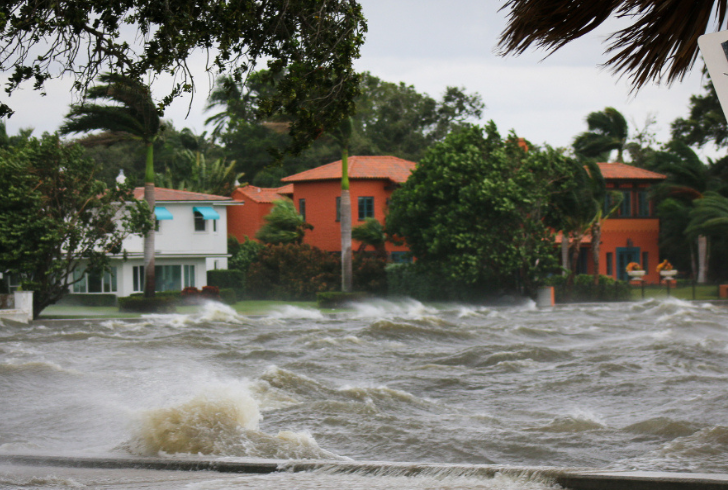The massive Category 5 Hurricane Milton is gaining strength as it moves across the Gulf of Mexico, with Florida in its sights. Expected to make landfall on Wednesday, this powerful storm has prompted evacuation orders for over a million residents along Florida’s densely populated west coast. This region, still recovering from Hurricane Helene just two weeks ago, is now bracing for potentially catastrophic impacts as Milton heads toward the Tampa Bay area.
Unprecedented Threat to Florida’s West Coast

Instagram | tampabaytimes | Hurricane Milton threatens Tampa’s west coast, urging residents to evacuate immediately.
Hurricane Milton is predicted to hit near the Tampa Bay metro area, home to over three million people. Many residents, who had barely begun clearing the debris left by Hurricane Helene, are now preparing for yet another major storm. Local officials have urged residents to evacuate as soon as possible, particularly those in low-lying areas vulnerable to storm surges.
With maximum sustained winds of 165 mph (270 kph), Hurricane Milton has already earned a place as one of the most intense storms on record in the Atlantic. The National Hurricane Center forecasts that wind speeds could drop to around 145 mph (233 kph) by the time Milton reaches Florida, potentially downgrading it to a Category 4 hurricane. But, even at this level, Milton would still pose a severe threat, with the potential to cause extensive damage and widespread power outages.
Rapid Intensification and an Unusual Path
Fueled by the warm waters of the Gulf, Hurricane Milton rapidly intensified from a tropical storm to a Category 5 hurricane in less than 24 hours. This level of rapid growth makes it the third-fastest intensifying storm recorded in the Atlantic. Adding to the storm’s unusual characteristics is its eastward path—most Gulf hurricanes form in the Caribbean Sea and move westward or northward.
Jonathan Lin, an atmospheric scientist at Cornell University, explains, “It’s extremely rare for a hurricane to form in the western Gulf, track eastward, and then hit Florida’s west coast. This track is critical because it determines where the storm surge will be most severe.” The Hurricane Center predicts storm surges of 10 to 15 feet along parts of Florida’s coast, both north and south of Tampa Bay, threatening entire communities with flooding.
Widespread Evacuations Underway
As Hurricane Milton continues to approach, counties along Florida’s western coast have issued mandatory evacuation orders. Pinellas County, which includes St. Petersburg, has instructed over 500,000 residents to evacuate. In neighboring Lee County, more than 416,000 people in low-lying areas have also been ordered to leave. Additional evacuation orders are in place for other coastal counties, including Hillsborough County, which encompasses the city of Tampa.
Local officials are bracing for significant logistical challenges as residents rush to leave. Long lines at gas stations and potential traffic congestion are among the primary concerns, with Tuesday serving as the last full day for evacuations.
A Storm Fueled by Gulf Waters
The Gulf of Mexico’s warm waters have provided ample fuel for Hurricane Milton, helping it grow into a massive, highly dangerous storm. Meteorologists expect Milton to remain a powerful hurricane as it crosses the Florida peninsula, maintaining intense winds and heavy rains that could impact the entire region.
As of 10 p.m. CDT on Monday, the storm’s eye was located 35 miles (60 km) north-northwest of Progreso, Mexico, near the Yucatán state capital of Merida. It was moving eastward at a speed of 9 mph (15 kph), with its sights set firmly on Florida. Milton is expected to batter the northern edge of the Yucatán Peninsula on Tuesday before continuing its journey toward the U.S. mainland.
Florida Prepares for Potential Catastrophe

Instagram | upscaleluxury | As Hurricane Milton approaches, residents in Florida are urgently preparing their houses for the potential impact of the storm.
Florida officials are urging residents to take this storm seriously, especially those in coastal and low-lying areas. With the painful memory of Hurricane Helene still fresh, many residents are anxious about the possibility of experiencing another devastating storm. Helene, which struck in late September as a Category 4 hurricane, caused over 200 deaths and billions of dollars in damage across six states.
The National Hurricane Center’s Deputy Director, Jamie Rhome, warned, “Milton is expected to expand in size as it approaches Florida, placing hundreds of miles of coastline within the storm surge danger zone.” Forecasts indicate that Milton will likely maintain hurricane strength as it moves across the Florida peninsula, leaving a wide path of destruction in its wake.
With Hurricane Milton bearing down, the focus now shifts to emergency preparations, evacuations, and the resilience of Florida’s communities as they brace for yet another major hurricane.










